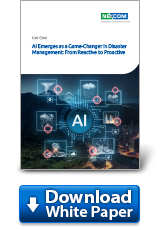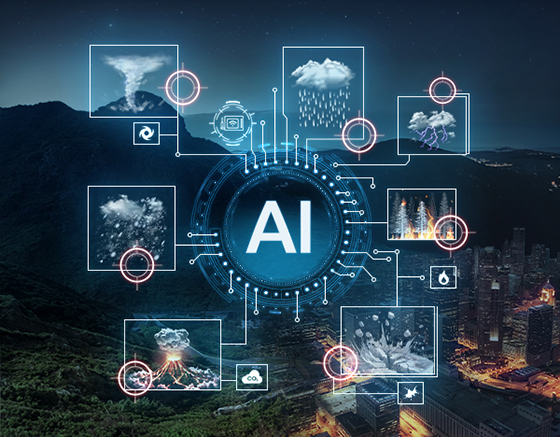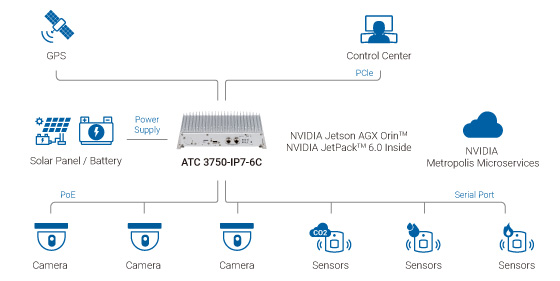AI Emerges as a Game-Changer in Disaster Management: From Reactive to Proactive

Limitations of Traditional Disaster Management Systems
Throughout history, humanity has constantly faced the threat of natural disasters such as earthquakes, hurricanes, wildfires, and floods, which have the potential to cause extensive destruction, loss of life, and property damage.
Traditional disaster management systems rely heavily on pre-defined rules, unvalidated statistical models, and human expertise and interaction, struggling to manage and process vast, diverse data streams and account for complex variables or unforeseen outcomes.

There are several examples demonstrating how traditional solutions available up until now have fallen short. For example, while satellite images are able to provide a broad overview of an area, due to the insufficient frame rate of the high-speed camera, insufficient detail in the image resolution, and limited camera angles, they might lack the fine detail needed for certain tasks, such as detecting shallow landslides or assessing damage to individual buildings. Geotechnical approaches using borehole inclinometers are expensive, complex, and time-consuming. It is also impossible to conduct continuous monitoring, which is not in line with the principles of scale.
High-performance computing and IoT technologies are reducing disaster damage
AI is changing the way disaster warnings are issued. AI, combined with IoT, edge computing, cameras, and sensors, is bringing about significant innovations in disaster prediction. By utilizing generative AI, deep learning, and machine learning algorithms to train on datasets from environmental sensors, environmental images, and disaster information, AI can learn about known disaster types and phenomena. Through trained models, it can identify potential disaster situations and signs that humans cannot directly find. In the early stages of disaster warning, it can identify the type, location, and time of potential disasters, and take proactive disaster prevention measures and actions to reduce the scope and impact of disasters.
Rugged edge AI computing platforms and IoT frameworks enable real-time AI disaster prediction and warning systems
AI can extract features and set labels from historical disaster datasets (including real-time environmental sensor values, high-resolution camera image files, and disaster fact records) to train various disaster models and identify potential disaster situations that are difficult for humans or traditional models to identify through model inference. Edge AI computing platforms can collect data sources from on-site sensors and cameras in real time and use pre-trained models to infer and identify disaster precursors to meet the needs of complex AI visual applications while also shortening warning response times. Combined with IoT frameworks, disaster prediction systems can be flexibly deployed in distributed geographical locations. In addition, disaster prediction SaaS developed with cloud-native environments and containerization technologies makes it easier to deploy AI models, AI inference engines, and microservices to edge AI computing platforms, accelerating the auto-scaling of cloud-ground integrated applications. However, disaster management systems in outdoor environments face several significant challenges. Here are some of the most critical ones:
Durability and Environmental Resilience: Outdoor equipment must be rugged enough to withstand harsh conditions, including extreme temperatures, rain, wind, dust, and even impacts from flying debris during disasters like wildfires, floods, or landslides.
Power Autonomy and Instability: Reliable power is crucial, but access to outlets can be limited outdoors. Disaster zones might even experience widespread power outages. This necessitates the system to be self-sufficient with a power generator or solar panels, which have limitations on power storage and energy collection, respectively. Furthermore, the voltage fluctuations caused by unpredictable power sources, such as damaged electrical grids, temporary generators, or solar panels with variable output depending on sunlight, also can disrupt the system's operation.
Robust Connectivity and Data Transmission: Outdoor environments may experience intermittent or limited network connectivity due to factors like terrain obstructions, weather conditions, or the sheer distance from communication infrastructure. This can lead to disruptions in data transmission and potential data loss, which can negatively impact the accuracy and timeliness of disaster management efforts.

System Architecture
NEXCOM's ATC 3750-IP7-6C is a rugged edge AI computing platform designed for harsh environments. In addition to its high-performance AI computing power, it also integrates wireless communication modules, a variety of wired communication interfaces, external environmental sensors, and high-speed cameras. Its tightly integrated mechanical design, high-airtight waterproof components, three-proof coating protection, vacuum airtightness, and submersion testing helps guarantee stable operation in harsh environments.
Powered by the NVIDIA Jetson AGX Orin system-on-module that delivers up to 275 (INT8) TOPS of AI performance, the ATC 3750-IP7-6C edge AI computing platform comes with the containerized operating system NAL (NEXCOM Acceleration Linux). With the NVIDIA JetPack 6.0 upgrade, it also features new Jetson Platform Services, which add foundational and AI analytics services, generative AI capabilities, and multiple building blocks such as the Video Storage Toolkit (VST) and NVIDIA DeepStream software development kit. This simplify solution development for developers by eliminating the need for repetitive development on NVIDIA Jetson, empowering them to quickly assemble full-featured edge AI systems and manage edge AI applications. Through REST APIs, developers can easily access a variety of microservices, enabling the construction of unified cloud-to-edge vision AI applications. This functionality delivers the seamless replication of cloud-developed microservices and trained AI models to edge devices using IoT gateway and OTA functions.
The alternative IoT OS for ATC 3750-IP7-6C is AIC OT-X. Bridging the gap between OT, IT, and IoT, AIC OT-X converges applications and microservices on edge devices. Industrial computers can be effortlessly transformed into software components. This powerful embedded IoT OS, compatible with x86 platforms, functions as an integrated OT and IoT gateway, supporting OPC UA. It empowers intuitive Docker image deployment from cloud to edge and effortlessly extends microservices for OT and AI applications.
The API gateway acts as a central hub for monitoring software usage, providing valuable insights into the utilization of various software functions. This information can be used to optimize resource allocation and ensure the system operates at peak performance. VST and DeepStream SDK microservices streamline the management, analysis, and optimization of inference performance for data coming from cameras and sensors. Developers can create sophisticated disaster sign recognition applications utilizing multi-camera tracking and zero-shot detection techniques powered by generative AI from the cloud to the edge.
One of the key advantages of the ATC 3750-IP7-6C is its ability to seamlessly integrate with a wide range of environmental sensors. With various I/O ports, including serial and digital I/O, as well as a CAN bus interface, the system can collect data from sensors deployed in the field, providing the necessary fuel for AI models tasked with detecting early warning signs of potential disasters. Through NAL's built-in hardware interfaces, developers can effortlessly access external sensors and peripheral devices using APIs. This intuitive approach simplifies the process of acquiring sensor data and controlling peripheral devices, allowing developers to focus on building innovative applications.
The sensors are deployed throughout the disaster zone to collect environmental data like temperature, wind speed, air quality, water levels, or ground movement. It can also be connected to more peripherals such as GNSS, IP cameras, and IEEE 1588 signal receivers.
Designed to withstand the harshest conditions, the ATC 3750-IP7-6C is built to operate in demanding outdoor environments; it is certified with the IP67 rating. With a wide operating temperature range (-20°C to 70°C), vibration and shock resistance that meets MIL-STD-810 standards, and a 9-36V DC-IN power input, this rugged-edge AI computing platform can be deployed in remote locations and continue functioning reliably, even in the face of extreme conditions.
Environmental sensor data, geospatial imagery, and geographic information can be transmitted to data centers via wired and wireless connections.
The ATC 3750-IP7-6C offers a comprehensive suite of communication options, including Gigabit Ethernet (with PoE+ support), Wi-Fi 5/6, cellular (LTE/5G), and GNSS capabilities. This ensures seamless data transmission and situational awareness, enabling effective coordination with other agencies or response teams.
People use various AI algorithms to classify images of collected data based on whether they should be reviewed or acted upon — if so, an alert is sent out to a command center. Staff from the control center can view the alert in real time and immediately rectify the risk. The technology company continuously refines AI models, provides probabilistic forecasts, and enables real-time monitoring for early detection. With advanced techniques like deep learning, AI can more effectively model highly complex, non-linear systems like weather patterns or wildfire behavior, potentially leading to more reliable, timely warnings and deeper insights into underlying disaster risks.
- Related Links:
- ATC 3563: Elevating Edge AI Performance for Smarter, Safer Construction Vehicles
- ATC 3562: Reinforcing Edge AI Intelligence in Harsh Environments
- Browse Other News:
- Urban PET Recycling Reinvented Sustainable Solutions Powered by NDiS B561
- AIEdge-X®80 Leaps Ahead: Power Up TOPS Performance with NVIDIA® Jetson™ Super Mode
- All Use Case News
